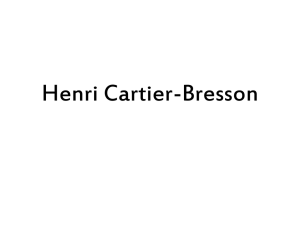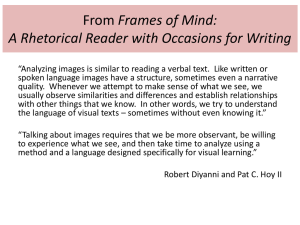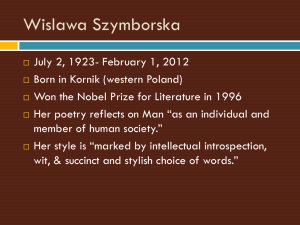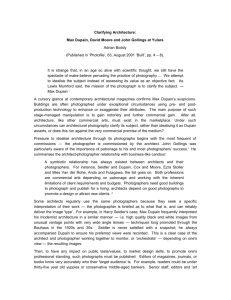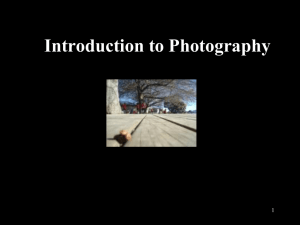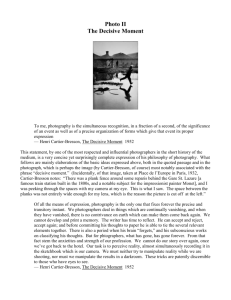HERRERA-kAYLA hERRER.. - Warilla High School Intranet
advertisement
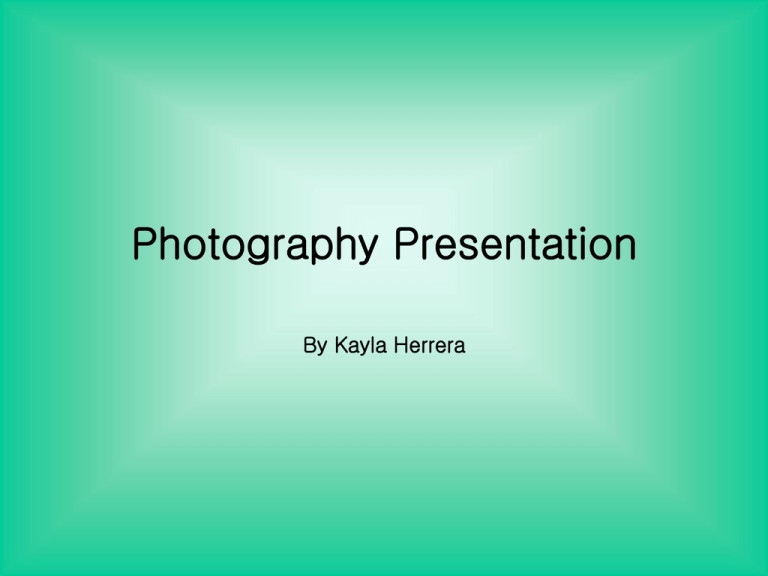
Photography Presentation By Kayla Herrera Outdoor Learning Area Drama Acting Taking It Easy Wondering Max Dupain • • Maxwell Spencer Dupain was born 4th April 1911. He received his first camera at the age of 13 and then 4 years later won the Carter Memorial Prize for Productive Use of Spare Time, a few years later joined the Photographic Society of NSW. By the year of 1934 Maxwell was struck out alone and opened his own studio in Bond Street, Sydney. In 1937, while holidaying on the coast of New South Wales Maxwell took a photograph of a the head and shoulders of a man lying on the beach, this photograph is known as the “sunbaker”. It is Dupain’s most famous piece, however it was not until the 1970’s that this photograph received wide recognition. In 1939, soon after the outbreak of World War 2 Dupain married Olive Cotton ( also a well know photographer), but sadly divorced soon after. During the war Dupain severed in the Royal Australian Air force in both Darwin and Papa New Guinea helping to create camouflage.After many years of war Dupain returned to photography with a greater emphasis on the documentary style. He also worked a great deal for the Colonial Sugar Refining Company Limited, while working for this company he made many trips to the interior and northern coast of Australia. Violinist at the Methodist Ladies' College in Sydney, by Max Dupain, 1971 What I Liked The thing That I absolutely loved about this photograph was the children playing there music. The use of the black and white makes it every effective and I think it looks brilliant. The girl playing violin and her peers singing in the background gives it a feeling, it just gives you that feeling that you are actually there with the girls and you just hear the music that they are playing. The fact that they are at school also makes this photograph special, Maxwell’s timing was perfect to capture the movement when the girl changed notes. I absolutely love this photograph and I could look at it for hours. Olive Cotton • Olive Cotton was born the 11th July 1911 Hornsby, Sydney. At the age of eleven Olive was given her first Kodak Box Brownie she was taught the basics of photography by her father, Leo Cotton. He was the professor of Geology at the Sydney University. Her mother Florence was interested in arts and music. Olive attend the Methodist Ladies Collage, Burwood, in 1921-1929 and then she attended Sydney University in 1930-1934 graduating BA. She joined the Photographic Society of NWS and the Sydney Camera Club in 1929. In mid 1934 she began to work with her childhood friend Max Dupain, in his newly opened studio at 24 Bond Street, Sydney. In 1939 after many years of working together Olive Cotton and Max Dupain were married. Olive also taught Mathematics at Frensham School, Mittagong (NSW) in 1941. Cotton moved to Koorawatha near Cowra in 1946 with her second husband, Ross McInerney, whom she had married in 1944; daughter Sally was born in 1946 and son Peter two years later. Cotton taught mathematics at Cowra High School from 1959-63. In 1964 she opened a photographic studio in Cowra specialising in portraiture, especially of children, and wedding photography. Jenny, 1937. What I liked • I really liked the use of the sunset in the photograph. It makes the women look like she is at peace and it also looks like a shoot from a movie. Her sitting in the sunset makes it look magical. The water at her feet gives me a relaxed and clam feeling and the sunset gives me the feeling of warmth. Henri Cartier-Bresson • Henri Cartier-Bresson was born August 22, 1908 in Cantaloupe-en-Brie,France and passed August 3 2004, he was a French photographer. He was commonly considered the disputed master of candid photography using the small-format rangefinder camera. He was known to many as the father of Photojournalism, Cartier-Bresson exclusively used Leica 35mm rangefinder cameras equipped with normal 50mm lenses or he occasionally a telephoto for landscapes. Along with Robert Cape and other photographers, Cartier-Bennson founded Magnum, the first photographic cooperative, in 1947. Cartier-Bresson’s early training in art helped him develop a subtle and sensitive eye for composition he studied art in a painting studio in Paris for 2 years. This was seen as one of Cartier-Bresson’s greatest assets as a photographer. In 1931, at the young age of 22 Henri went to West Africa as a hunter, after a year of hunting he returned to Paris after catching backwater fever. When World War 2 broke out, CartierBresson briefly server in the French Army. During the battle if France, he was captured by the Germans and after 2 unsuccessful tries, he escaped from a prisoners of war camp. He then worked with the French Resistance until the war’s ended. CartierBresson died in Céreste( Alps-de-Haunté-Province,France) on August 3,2004 at the age of 95. Queen Charlotte's Ball, London What I liked • I love the effect of the black and white photography it just gives it a great effect and also makes it look very elegant. The birds-eye view is a great technique used in this photo it shows so much more than a eye-level view photo. I also love how Henri has taken the photograph while they are dancing it just looks so elegant and wonderful. Elliott Erwitt • Born in Paris of Russian immigrant parents, Erwitt served as a photographer's assistant in the 1950's in the United States Army while stationed in France and Germany. Erwitt was influenced by meeting famous photographers such as Edward Steichen,Robert Cape and Roy Stryker. Stryker, the former director of the Farm Security Administration’s photography department, hired Erwitt to work on a photography project for the Standard Oil Company, Erwitt then began a freelance photographer career and produced work for Collier’s,Look,Life and Holiday magazine. Since the 1970’s Erwitt has dedicated much of his time in the film making industry some of his feature films, television commercials and documentaries include, Beauty knows No Pain (1971), Red,White and Bluegrass (1973) and the prize-winning Glassmakers of Heart, Afghanistan (1977). What I Liked • I loved this photograph I was attracted to it because I love how he used the black and white. The photographs that have been taken like this I absolutely love them. I just think that it gives so much emotion and without having the colour in the photograph makes you think about what her costume would look like in colour. It really makes you think and you ask yourself questions like what colour tutu would she have? What colour leotard would she have on? It just brings those kind of questions to mind. I also love this photograph because I love ballet and I think it looks beautiful.
